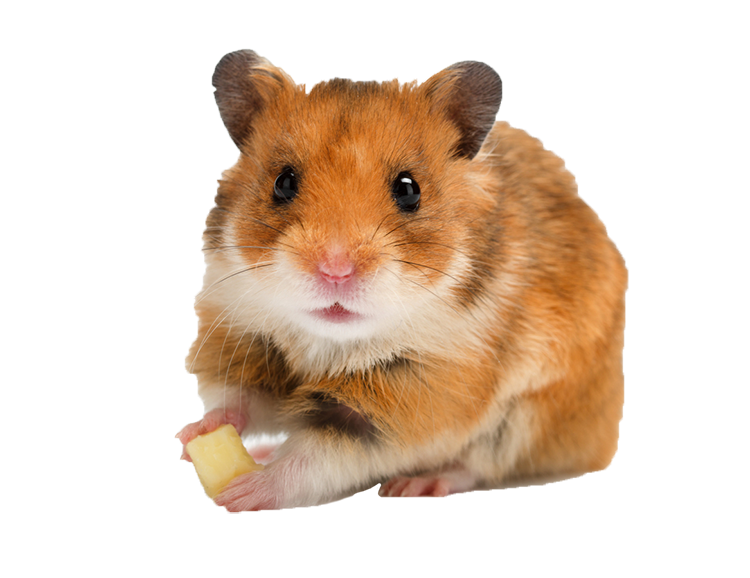Our animal hospital is dedicated to providing quality veterinary care to all pets, no matter how big or small. If you’re looking for a hamster vet, we recommend bringing your pet hamster to our hospital at least once a year for a wellness exam. If you notice your hamster experiencing any symptoms of illness, such as decreased appetite, decreased defecation, discomfort, or acting quieter than normal, call our hospital to schedule an exam with a veterinarian!
Age-related Wellness Programs
Adequate housing, a proper diet and exercise, and routine preventive care are essential to providing your hamster with a happy, healthy life.

Some ways to ensure your hamster’s health and well-being include:
Feeding your pet good quality hamster pellet diet
Offering them small amounts of fresh fruits and vegetables
Housing multiple hamsters individually
Providing your hamster with a large cage, complete with proper nesting material and bedding
Supplying hamster balls, wheels, and tunnels to keep your pet active
Hamster Care Instructions
- Feed a good quality hamster pellet or rodent chow with a minimum of 24% protein. Avoid cereal, fruit, seed, and grain mixes as they can lead to obesity, dental problems, and vitamin E deficiency.
- Our veterinarians recommend Oxbow band pellets and hay.
- Offer small amounts of grass hay (oat, timothy, orchard, or meadow) daily.
- Offer no more than ¼ teaspoon of fresh fruits and vegetables per day.
- Avoid treats high in sugar, such as yogurt treats, and only offer sparingly.
- Hamsters are nocturnal and will instinctively burrow and hoard their food.
- Provide enrichment in the form of tunnels, solid plastic exercise wheels, nest boxes, and paper items for chewing.
- Hamsters need exercise wheels that accommodate their specific size. Syrian hamsters, for example, are larger than dwarf hamsters and should have a wheel that is at least 12 inches in diameter to prevent them from bending their spine. Dwarf hamster wheels should be a minimum of 8 inches in diameter. To prevent leg injuries, use only wheels with a solid running surface, instead of wires.
- Hamster balls allow your hamster to safely explore the environment outside of their habitat. Make sure to supervise your hamster when they are exploring to prevent injury or unwanted interactions.
- Because of their small size and adorable faces, hamsters are often marketed as “starter pets” for children. However, they are nocturnal and just when it’s time for your child to go to sleep, it’s time for a hamster to wake up. A hamster awakened suddenly from a nap during the day may bite or become distressed. Hamsters require a gentle touch and can be easily startled by sudden movement or loud noises. Younger children who lack fine motor control and self-restraint may inadvertently drop a hamster, squeeze them, or scare them into biting.
- Young children are also at greater risk for zoonotic diseases (diseases that can be passed from animals to humans) because of their undeveloped immune systems and tendency for close contact with pets without proper hand-washing. Therefore, children should only handle hamsters with adult supervision.
- Tubes for hamsters replicate the tunnels they dig in the wild and are a good form of enrichment. However, plastic tubes can end up causing more harm than good. Cardboard and wooden tubes are advised, as chewing plastic leads to ingesting small fragments. Using plastic tubes can put your hamster at risk of getting stuck, overheating, dehydration, lack of oxygen, discouraging burrowing behaviors, ammonia buildup, fur loss as a result of constant friction, and even death. Using toilet paper/paper towel rolls (as long as they are wide enough) can be a wonderful alternative for dwarf hamsters. Larger packing tubes are a more appropriate alternative for the larger Syrian hamsters.
- Most plastic balls should be avoided for the same reasons as plastic tubes, but clear plastic balls with ventilation can be used for exploration outside of the cage. For added safety, secure the covers with tape to prevent escape from the ball. Do not leave the ball in your hamster’s cage where they can chew on it.
- The enclosure should be placed in a room with a stable temperature around 68-75° and 40-60% humidity.
- It is best to house hamsters individually as they tend to fight when housed together.
- Provide the largest cage possible to allow your hamster plenty of room to roam, eat, play, and hide. Stainless steel, durable plastic, and wire mesh cages are all appropriate for hamsters.
- Ample nesting material and a deep layer of paper-based absorbable bedding should line the flooring of the cage. Avoid pine, cedar, and aspen bedding.
- A full cage cleaning should be performed at least once weekly. Make sure to deeply rinse all cage and furniture surfaces after cleaning and allow them to air dry.
- Avoid housing your hamster where they can be exposed to candles, scented products, essential oil diffusers, or scented cleaning products.


